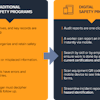
Getting rejected when you apply for credit is never a good feeling. But not only does it affect your mood, it can also affect your company’s ability to borrow in the future.
Since every official “no” from a lender can negatively affect your credit scores, it’s important for companies to avoid credit rejections whenever possible. For clarity, we are talking about “a full credit application was submitted” rejection where a hard credit inquiry was used, and not quick pre-approvals or soft inquiries. We are also assuming mainstream B2B lenders, and not “bad credit/no credit ok” lenders (more on that later).
In applying for business credit, sometimes a “no” can be surprising. But all too often, that “surprising” credit rejection shouldn’t have been a surprise at all, as the reason(s) for the rejection were plain as day to the lender.
Most mainstream B2B lenders have three tiers for application approvals and rejections:
- Automatic rejection (typically algorithm-driven)
- Passes initial algorithms but subject to human review
- Automatic approval
In the paragraphs that follow, we’re going to discuss #1 – these automatic rejections that sometimes catch companies by surprise – and how to better avoid them. Note that these are overall impressions from a 30-year business lending professional, and not an absolute. Nobody can 100% guarantee an approval or a rejection avoidance. That said, let’s go:
Three “Automatic Rejection” Red Flags for Most Lenders
While there are plenty of criteria that go into a credit decision, most mainstream B2B lenders have three basic red flags that will almost always result in an automatic rejection of a business credit application. They are:
- Less than two years in business
- Poor credit scores
- A recent (less than 7 years ago) bankruptcy
To help companies minimize these easily-avoidable automatic rejections, let’s look at these a little closer.
Time In Business
Time in business is an important criterion for most lenders, and two years is a magic number in many cases. According to the Small Business Association, a full one-third of new businesses will not make two years.
Of course, passing two years is no guarantee of success (or a loan). Business lenders may want to see more time in business depending on the industry or other circumstances. However, less than two years is an automatic rejection in most cases. So if you are under two years in business, you’d be better served to wait for the two-year anniversary before applying if you want to avoid a “surprise” automatic rejection.
“Less than Good” Credit Scores
For credit scores, a novel can truly be written, so here’s the big picture version:
Depending on the borrower (business configuration/company background), a lender will use a combination of credit history from a fairly large variety of sources, including “the big 3” credit reporting bureaus (Equifax, Experian, TransUnion), Secretary of State databases, D&B, LexisNexis, Thomson Reuters, Paynet, and others. In the absence of long-established credit in the business name, the company principal’s personal credit will be closely looked at.
Along with this large array of credit sources, countless pieces of information and data are crunched in complex algorithms to assist in making approval decisions. It’s impossible to be any more definitive here, as the potential combinations and outcomes are virtually limitless.
However, almost every company (and every person) has a good idea of where their credit stands, at least in an overall sense. Credit data is readily available to consumers and businesses, much of it for free. And almost every scoring system out there has what they consider a “good” score.
In today’s world, nothing is hidden and nothing will be overlooked. So to better avoid an automatic rejection, a company should make sure its credit (and that of its principals, if necessary) can withstand thorough scrutiny from multiple angles and still be above the “good” level. Because if it isn’t, most mainstream lenders are going to reject the application automatically.
Recent Bankruptcies
A recent (less than seven years ago) bankruptcy (either personal or business) will cause an application to be automatically rejected by most lenders. Again, we can write a novel on this, but advanced data has steered many mainstream B2B lenders to automatically reject recent bankruptcies. It’s not personal – it’s numbers.
This is one of the largest causes of surprise in business lending rejections. A company applying may have a bankruptcy less than seven years ago, but their time in business is solid, and their credit history has again passed the “good” threshold. So knowing that, the company feels confident about their borrowing chances, especially since the bankruptcy was five long years ago, and the circumstances that led to it have been resolved.
Nope – seven years is a key timeframe for most lenders. If there’s a recent bankruptcy, a company may wish to wait until the seven-year mark has passed before submitting the official application. It may save an automatic credit-affecting rejection they may not have been expecting.
What Can a Company Do If Any of These Exist?
If any of these “red flag” conditions exist, the best course of action is to simply let time go by. Because every one of these instances can be resolved with the passage of time (assuming good credit practices of course).
There are also “bad credit/no credit ok” lenders out there. However, if a company must go in this direction, research and make sure the collateral requirements, repayment and interest schedule and any other restrictions are completely understood (emphasis on completely). The Golden Rule of lending is the more relaxed the borrowing criteria, the higher the rate and the more confining the restrictions. Food for thought.
Wrapping Up
Most credit rejections can be avoided if the applicant has a good idea of what the lender looks at. With a bit of diligence and an honest assessment of credit histories, companies can better avoid harmful credit-score-affecting rejections.
Chris “Fletch” Fletcher is the VP of National Accounts for Crest Capital.


















